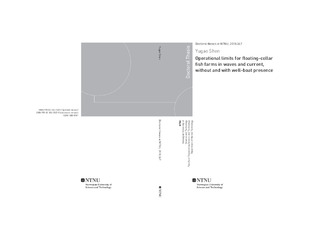| dc.description.abstract | Dynamic response of a floating circular collar-type fish farm, without and with well-boat presence, in current, regular and irregular waves is analyzed. A modern design well boat and a realistic fish farm (with single cage) are considered. The latter comprises a floating collar, an elastic sinker tube, a flexible-closed net cage and a complex mooring system. The main purpose is to determine the operational conditions for the isolated fish farm and for the well boat-fish farm system. This study involves theoretical development, numerical investigations and analysis of experiments on a realistic fish-farm model (not carried out in this research).
A time-domain numerical solver for the fish farm is developed with the different components modeled with the state-of-the-art theoretical and numerical formulations. For instance, the motions of the floating collar and the sinker tube are described by a curved beam equation with consideration of axial stiffness and curvature effects. In terms of the net cage, the net twines are modeled as linear elastic trusses. The hydrodynamic loads on the net cage are estimated by the screen-load model, which accounts for hydrodynamic net-shadow and Reynolds number effects. Proper strategies are suggested to deal with the coupling between the different components and a solution algorithm, with a criterion to prevent unphysical negative net tensions, is proposed. The modeling of the different components is validated by comparing against documented experiments, involving simplifications of the various components.
The validated numerical tool is used to analyze a realistic aquaculture fish-farm system (with single cage). The mooring loads obtained from the numerical simulations are compared against available experimental data. Satisfactory agreement is demonstrated both in regular and irregular waves. A sensitivity analysis is also performed to identify important parameters influencing the mooring loads, showing which net cage related parameters are crucial. The operational limits of the fish farm are determined through systematic simulations in regular waves and current, indicating that the net volume reduction is the main constraint preventing the studied fish farm operating in more exposed regions.
Theoretical models of a well boat operating at a fish farm in current and in long-crested irregular waves and current are also introduced. The transverse viscous loads on the boat are estimated based on the cross-flow principle and the corresponding drag coefficients are evaluated based on an empirical approach accounting for Reynolds number, rigid free-surface condition, three-dimensional flow at ship ends, Keulegan-Carpenter number and the ratio between current velocity and a characteristic wave velocity. The proposed estimation strategy is validated by available experimental results. The coupling between the well boat and fish farm is carefully modeled. The numerical modeling of the slow-drift motions of the well boat, in particular the slow-drift sway motion, is outlined and verified by comparing the mean value and standard deviation of the motion from time-domain and frequency-domain solutions. The importance of different slow-drift damping terms is also discussed.
A physical investigation of the coupled system in long-crested irregular waves and current is then performed. The most critical scenario with the well boat placed at the weather side of the fish farm is analyzed in detail. From the simulations, the well-boat presence will significantly increase the maximum anchor loads and the maximum floating-collar stress, which are two important variables for the structural integrity of the fish farm. In particular, an increment of more than 300% is observed for both variables in moderate exposure sea states. A sensitivity study is also performed to figure out important parameters influencing the two variables and the possibility to increase the computational efficiency by simplifying the modeling. The results highlight that the netting has a small influence on the maximum floating-collar stress when current is present. Systematic simulations are also performed to determine the operational conditions of the coupled system. Numerical results show that the maximum stress in the floating collar can be close to the yield stress when the system operates in moderate exposure sea states, thus it should be of major concern.
The applicability of using equivalent regular waves to represent irregular waves is also discussed in terms of the mooring loads. For the isolated fish farm, the mooring loads in equivalent regular waves are of similar magnitude, but generally more conservative than those in irregular waves. | nb_NO |
